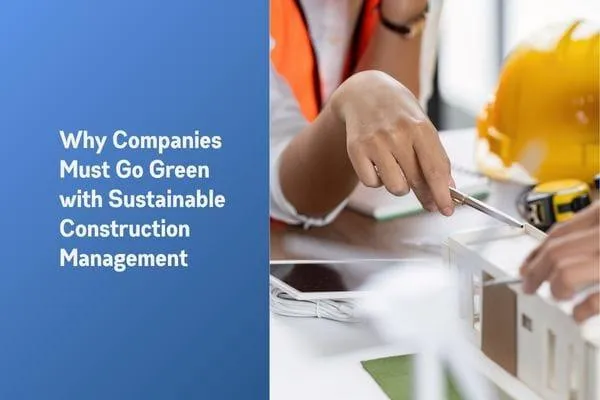
Why Companies Must Go Green With Sustainable Construction Management
For years, construction has been all about finishing the job quickly and moving on. In that race to wrap things up, we’ve ignored the piles of waste, the rising pollution, and the energy that gets burned along the way. Now we’re living with the results of those choices.
Think about the spaces you live, work, or study in. Wouldn’t you want them to be healthier, cost less to maintain, and last longer?
That’s why sustainable construction management matters today more than ever. It focuses on planning better from the start, using fewer materials, reducing waste, and building spaces that last longer without costing more down the road.
In this article, you’ll learn exactly what sustainable construction management is. You’ll also see why starting it now saves money, improves building quality, and protects the planet.
Why Companies Must Go Green With Sustainable Construction Management
What is Sustainable Construction Management?
Why Start Sustainable Construction Management Today?
The 7 Core Principles of Sustainable Construction Management
4. Waste Reduction and Recycling
5 Practical Steps to Implement Sustainable Construction Management
1. Start with Smarter Material Selection
2. Integrate Effective Project Planning
4. Be Energy and Water Conscious
5. Keep Worker Safety and Well-being in Mind
Careers and Opportunities in Sustainable Construction Management
What is Sustainable Construction Management?
Sustainable construction management is the way projects are planned and executed to balance efficiency, cost, and environmental responsibility. It combines the practical side of construction with strategies that reduce waste, conserve resources, and prioritize long-term benefits.
For example, rather than ordering excess cement that ends up in a landfill, sustainable management looks at accurate material planning and reuses leftovers.
It also means choosing materials that are durable, local, and low on emissions, and employing construction techniques that reduce energy use. But sustainability extends to workers and communities. Safe working conditions, reduced pollution, and minimizing site disruption are all part of it.
Projects managed this way last longer, cost less in the long run, and create healthier buildings for the people who use them. In short, sustainable construction management focuses on smart, responsible decisions at every stage of building.
Why Start Sustainable Construction Management Today?

Delaying sustainable practices comes at a cost. Every day that waste piles up, energy goes unchecked, and regulations tighten, you risk higher expenses, slower approvals, and missed business opportunities.
Clients are also paying attention. A report by Dodge Data & Analytics revealed that 28% of industry professionals currently report that most of their building projects qualify as green, and 42% anticipate reaching that level within the next three years, expanding that group by 50%.
This growing demand for green buildings is a shift towards more sustainable practices in the industry. Beyond money, the legal landscape is changing. Cities worldwide are introducing stricter building codes focused on efficiency and waste reduction.
Companies that adopt sustainable construction now are the ones that will stay ahead as regulations tighten. Acting now leads to lower long-term risks, improving brand reputation, and positioning your team as experts in modern construction practices.
The 7 Core Principles of Sustainable Construction Management
Sustainable construction begins with a mindset: every choice you make matters. From the materials you select to how you organize your team, each step shapes the building’s impact on the environment, budget, and people.
These seven principles act as a roadmap to guide your decisions while keeping projects efficient, cost-effective, and eco-friendly.

1. Efficient Resource Use
Using resources wisely means thinking ahead. Every piece of steel, concrete, or timber has a cost, both financially and environmentally. Choosing durable materials that last longer reduces waste and avoids rework.
Planning how much of each material is required prevents over-ordering, and leftovers can often be reused in other areas. As much as 30% of all building materials delivered to a typical construction site can end up as waste. Smart use of materials ensures nothing goes to waste and every piece serves a purpose.
2. Energy-Smart Operations
Energy is one of the biggest hidden costs on a construction site.
Machinery, lighting, and temporary facilities consume fuel and electricity every day. Managing energy use means scheduling equipment to avoid idle time, using fuel-efficient machinery, and switching to renewable sources where possible.
Sites that adopt these practices see a direct reduction in costs. Planning energy usage carefully also reduces emissions, making the project greener and giving a competitive edge in markets where clients demand environmentally responsible construction.
3. Water Conservation
Water on a construction site is often wasted without anyone realizing it. Concrete mixing, dust control, and cleaning tasks consume thousands of liters daily. Sustainable sites capture rainwater, recycle wastewater, and limit unnecessary use.
By using water efficiently, sites can cut costs and reduce environmental impact. According to the U.S. Environmental Protection Agency, water utilities can save 15–30% by implementing energy efficiency practices and managing costs.
Smart water management also ensures compliance with local regulations, especially in regions facing water scarcity, making your project more resilient and respected by the community.
4. Waste Reduction and Recycling
Construction generates a lot of leftover materials, but that doesn’t mean they have to go to waste. Managing waste effectively starts with planning how much material each phase requires and organizing the site so scraps can be reused or recycled.
Concrete can be crushed into aggregates, wood can find a second life in other projects, and metal scraps can be sold back to suppliers. This approach keeps the site cleaner, reduces unnecessary disposal costs, and even frees up storage space.
Practicing waste reduction and recycling is a way to make every material count, save money, and show clients that your project respects the environment.
5. Health and Safety
Construction remains one of the riskiest industries in the world.
Roughly one in six fatal workplace accidents happens on a construction site, adding up to over 60,000 deaths each year globally. Despite these numbers, most accidents have known causes and can be prevented with proper planning and management.
A construction manager who prioritizes occupational safety, through clear safety procedures, personal protective equipment, and ongoing worker training, can drastically reduce risks.
Focusing on health and safety not only protects the team but also keeps projects on track, saves costs from delays, and builds a stronger reputation for reliability and professionalism.
6. Community Impact
Construction projects affect the site and the people living around it as well. Noise, dust, and traffic can create tension with neighbors and even slow down your progress if complaints arise.
Sustainable construction management centers on minimizing these disruptions by planning delivery schedules, controlling dust with water sprays, and limiting heavy work during sensitive hours. A project that respects its surroundings not only avoids conflicts but also builds goodwill and trust within the community.
Thinking about the people around the site helps construction managers keep projects on schedule and maintain positive relationships. It also strengthens the reputation of both the company and the team.
7. Lifecycle Thinking
Every structure built today will be used for decades, so decisions made during construction shape its future. Lifecycle thinking encourages managers to consider durability, long-term maintenance, and operational efficiency from the start.
Select materials that last, design systems that save energy, and plan spaces for future adaptability. This makes sure that the building remains cost-effective and functional over time.
By thinking beyond the immediate project timeline, construction managers protect the investment of clients while promoting sustainability.
Lifecycle thinking turns a building from a short-term project into a long-term asset, benefiting both the environment and everyone who will live, work, or use the space.
5 Practical Steps to Implement Sustainable Construction Management
Transitioning to sustainable practices isn't something that can happen overnight. It's about taking steps that are practical, measurable, and cost-effective.

1. Start with Smarter Material Selection
Choosing the right materials is the foundation of sustainable construction. That's why we opt for locally sourced supplies to cut transport costs and emissions. Use materials that are durable and can be reused or recycled.
For example, steel beams, treated timber, and recycled concrete can reduce both waste and expenses. The key is thinking ahead, every material ordered should have a purpose and a plan for leftover portions.
2. Integrate Effective Project Planning
Sustainability starts before the first brick is laid. Plan deliveries to avoid overstocking, schedule tasks to minimize idle machinery, and organize teams so that work flows smoothly.
Tools like BIM (Building Information Modeling) allow you to see the entire project digitally, which helps prevent mistakes and reduces wasted materials. Consider it as having a roadmap for every nail and every bag of cement.
3. Reduce Waste Naturally
Waste happens, but it doesn’t have to pile up. Think about concrete scraps, metal pieces, or leftover wood and how they can be reused. Crushing old concrete into aggregates or giving scrap metal to another project turns potential waste into value.
Even small practices, like storing materials carefully and separating them by type, make the site cleaner and operations smoother. Over time, these habits save money and earn respect from clients who value efficiency and responsibility.
4. Be Energy and Water Conscious
Look around the site and notice where energy and water are being used. Simple things, like turning off lights when not needed, running tools efficiently, or capturing rainwater for washing and curing concrete, make a real difference.
These measures keep operational costs lower and demonstrate to clients that the project is being run responsibly. On a large site, small improvements like this can add up to thousands saved over a project’s duration.
5. Keep Worker Safety and Well-being in Mind
Looking after your team makes a huge difference on-site. Keep the site safe, manage dust, provide proper ventilation, and maintain comfortable working conditions. That's how you ensure the crew's productivity.
Moreover, healthy and motivated workers make fewer mistakes and stay on track, which benefits the entire project. Paying attention to your team’s well-being is one of the simplest, yet most effective, steps toward sustainable construction.
Careers and Opportunities in Sustainable Construction Management
The shift toward sustainable construction is creating new roles and opportunities for professionals. Companies now need managers who understand green building practices, energy efficiency, and long-term maintenance planning.
Job Roles: Positions include sustainability officers, green project managers, energy auditors, and LEED consultants. These roles require both traditional construction knowledge and a focus on eco-friendly strategies.
Education and Training: Many universities and online platforms offer sustainable construction management courses and certifications. For professionals in the field, even short courses can improve credibility and lead to higher-paying projects.
Skill Demand: Employers value professionals who can reduce costs, minimize waste, and deliver eco-compliant projects. If you learn these skills now, you’re preparing for a career that will be increasingly in demand over the next decade.
Final Word from Purely Startup
Every construction project has the potential to leave a positive mark on clients, the environment, and the community around it. When deliveries are timed right, materials are reused, and energy and water use are planned carefully, a site becomes more organized and safer.
Choosing local materials, repurposing leftover concrete, and keeping track of every scrap may seem small, but they save money, reduce stress, and show clients that quality and care matter.
Teams notice when work flows smoothly, and clients notice professionalism. Starting these practices means leaving buildings that perform well for years – gaining trust, and building a reputation as someone who delivers smarter, responsible, and lasting construction.


